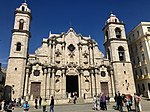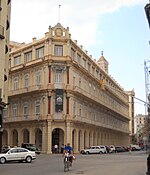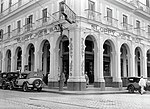Parque Central, Havana
Buildings and structures in HavanaCuba geography stubs

The Parque Central, Havana is one of the best known and central sites of the city of Havana, Cuba. It is located between Prado, Neptuno, Zulueta and San José streets, and San Rafael Boulevard. Among the buildings surrounding the park are Gran Teatro de La Habana (The Great Theatre of Havana Alicia Alonso), the Hotel Inglaterra (England Hotel), the Hotel Telégrafo, el Hotel Parque Central (Central Park Hotel), la Manzana de Gómez, the Hotel Plaza and Museo Nacional de Bellas Artes.
Excerpt from the Wikipedia article Parque Central, Havana (License: CC BY-SA 3.0, Authors, Images).Parque Central, Havana
Paseo de Martí (Paseo del Prado), Havana
Geographical coordinates (GPS) Address External links Nearby Places Show on map
Geographical coordinates (GPS)
| Latitude | Longitude |
|---|---|
| N 23.1375 ° | E -82.3587 ° |
Address
Parque Central
Paseo de Martí (Paseo del Prado)
10000 Havana (Prado)
Havana, Cuba
Open on Google Maps











